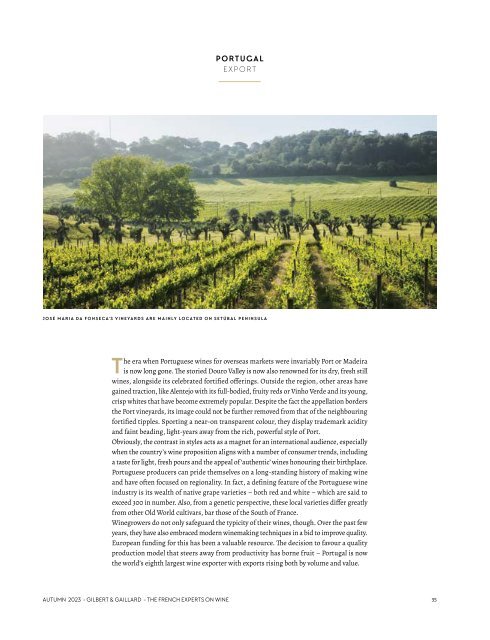You also want an ePaper? Increase the reach of your titles
YUMPU automatically turns print PDFs into web optimized ePapers that Google loves.
<strong>PORT</strong>UGAL<br />
EX<strong>PORT</strong><br />
JOSÉ MARIA DA FONSECA’S VINEYARDS ARE MAINLY LOCATED ON SETÚBAL PENINSULA<br />
T<br />
he era when Portuguese wines for overseas markets were invariably Port or Madeira<br />
is now long gone. The storied Douro Valley is now also renowned for its dry, fresh still<br />
wines, alongside its celebrated fortified offerings. Outside the region, other areas have<br />
gained traction, like Alentejo with its full-bodied, fruity reds or Vinho Verde and its young,<br />
crisp whites that have become extremely popular. Despite the fact the appellation borders<br />
the Port vineyards, its image could not be further removed from that of the neighbouring<br />
fortified tipples. Sporting a near-on transparent colour, they display trademark acidity<br />
and faint beading, light-years away from the rich, powerful style of Port.<br />
Obviously, the contrast in styles acts as a magnet for an international audience, especially<br />
when the country’s wine proposition aligns with a number of consumer trends, including<br />
a taste for light, fresh pours and the appeal of ‘authentic’ wines honouring their birthplace.<br />
Portuguese producers can pride themselves on a long-standing history of making wine<br />
and have often focused on regionality. In fact, a defining feature of the Portuguese wine<br />
industry is its wealth of native grape varieties – both red and white – which are said to<br />
exceed 300 in number. Also, from a genetic perspective, these local varieties differ greatly<br />
from other Old World cultivars, bar those of the South of France.<br />
Winegrowers do not only safeguard the typicity of their wines, though. Over the past few<br />
years, they have also embraced modern winemaking techniques in a bid to improve quality.<br />
European funding for this has been a valuable resource. The decision to favour a quality<br />
production model that steers away from productivity has borne fruit – Portugal is now<br />
the world’s eighth largest wine exporter with exports rising both by volume and value.<br />
AUTUMN 2023 • GILBERT & GAILLARD - THE FRENCH EXPERTS ON WINE<br />
35

















